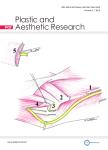Comparison of breast reconstruction using ipsilateral and contralateral pedicle transverse rectus abdominis musculocutaneous flaps
Comparison of breast reconstruction using ipsilateral and contralateral pedicle transverse rectus abdominis musculocutaneous flaps作者机构:Cancer InstituteTehran University of Medical SciencesImam Khomeini HospitalTehran 13145-158Iran.
出 版 物:《Plastic and Aesthetic Research》 (整形与美容研究(英文版))
年 卷 期:2017年第4卷第9期
页 面:155-160页
学科分类:1002[医学-临床医学] 100214[医学-肿瘤学] 10[医学]
主 题:Breast reconstruction transvers rectus abdominis musculocutaneous flap unilateral pedicle TRAM flap ipsilateral pedicle TRAM flap
摘 要:Aim: Breast reconstruction has several beneficial effects on psychosocial well-being and quality of life. The ultimate goal has always been to create the most natural breast mound. Thus in many centers, the unilateral pedicled transverse rectus abdominis myocutaneous (TRAM) flap remains the most common technique for breast reconstruction. Our objective was to retrospectively compare the outcomes of ipsilateral and contralateral pedicle TRAM flaps. Methods: The total of 110 patients underwent unilateral breast reconstruction with pedicle TRAM flap at Cancer Institute of Tehran University of Medical Science from January 1996 to June 2011. Premorbid risk factors, postoperative outcomes and demographic data were assessed. The analysis of the recordings was done by SPSS 20. Results: Out of 110 patients who were included in the study, 87 had ipsilateral and 23 contralateral pedicle TRAM flaps. The incidence of flap complications that did not require surgical intervention was 19.7% in ipsilateral and 30.4% in contralateral pedicle TRAM flap. The incidence of flap loss requiring revision was significantly higher in contralateral group (P = 0.001). Major complications were noted in 11.5% of the ipsilateral pedicle TRAM patients and 26.1% of the contralateral group (P 0.001). Minor complications were noted in 17.2% of the ipsilateral pedicle TRAM patients and in 34.8% of the contralateral group (P 0.001). Total early hospital stay was longer in contralateral pedicle TRAM flaps (7.66 days vs. 10.68 days, P = 0.83). H igher c omplications were e ncountered i n c ontralateral p edicle T RAM flaps compared to ipsilateral pedicle TRAM patients (39.1% vs. 19.5%, P = 0.001). The type of pedicled TRAM flap (ipsilateral vs. contralateral), had significant effect on complications (odds ratio = 0.007, P = 0.002) while other variables had no significant effect on the incidence of complications. Conclusion: This study indicates that the overall outcome and mid-term morbidity-free surv



